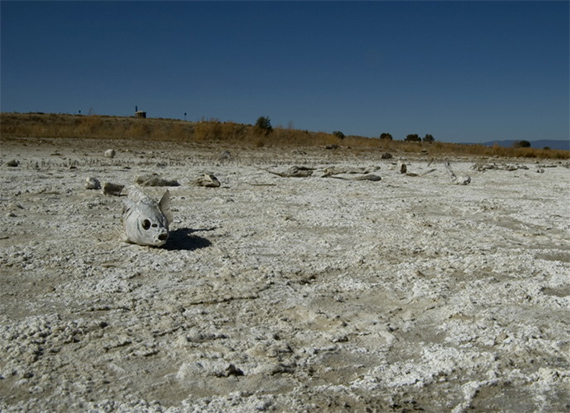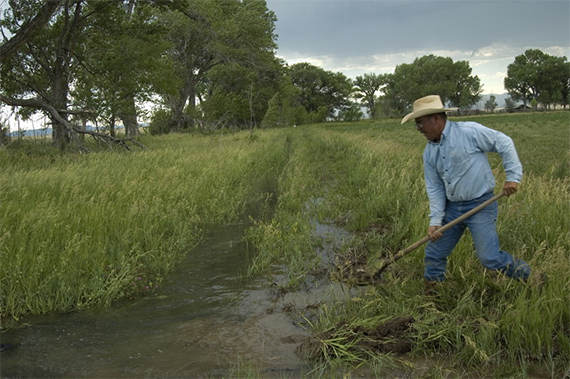Water, “cool, clear water,” as the Son’s of the Pioneers used to sing, is among the most beautiful things in the world – and in New Mexico and the American West it’s among the rarest, most complicated and contentious too.
We’ve never had a lot of it, and with climate-change triggered drought and urban overpopulation we have less and less of it that we can use productively. Our water system in the West has become drastically destabilized. It is in danger of a historic collapse. And because we have never been weaned from water squandering, and have abused the natural systems upon which we depend, the water crisis we’re facing will become a world of hurt for most of us. Imagine the political firestorm if Albuquerque households were forced by conditions to use 50 gallons of water day, like they do in Berlin and other European cities. That’s a two thirds reduction of our current usage. It could come to that. It could also unleash a tempest of propaganda directed against agricultural users who most cities try to blame for using up “all that water.”
“As a state, we are ill-prepared for a prolonged drought, and nowhere more so than in terms of protecting our natural systems,” writes Denise Fort, director of the UNM’s Utton Center for the study of water. “If there ever were a time that calls for a reorientation of our perspective toward the natural environment,” she wrote, “this is it.”
 (Dead carp at McAllister Lake near Las Vegas. Images by: Nell Farrell)
(Dead carp at McAllister Lake near Las Vegas. Images by: Nell Farrell)
The Land of Enchantment is a small fish in a shrinking pool with big sharks, looking to gobble up whatever water they can get away with. Although all the sharks look different, they’re all the same – voracious, rich, water-wasting states with crucial agricultural needs and guzzling metroplexes – from California and Nevada to Texas and Arizona -- each with huge legal war chests to contest every drop of water they can, anywhere in the region. It’s reported that Texas has banked $1 billion for its water wars over the delivery of Rio Grande water, and perhaps water from the Pecos, against New Mexico.
And the biggest great white shark of all is the federal government, which has the power of the spigot, the power to turn it off.
One of the most momentous and telling events in recent water history saw California losing some 750,000 acre feet of water from the Colorado River at the stroke of midnight January 2003. To put that number in perspective, Albuquerque’s allotment of Colorado River water is around 48,000 acre feet a year. The U.S. Supreme Court had ruled in Arizona v. California that California’s use of surplus river water that potentially belonged to Arizona finally had to come to a stop.
California could get the surplus as long as Arizona had no way to use it. But when the 336 mile long Central Arizona Project (CAP) aqueduct was built, moving water from Lake Havasu City on the Colorado River to Phoenix and Tucson, California couldn’t hold off Arizona’s rights forever. In November of 2002, Secretary of Interior Gale Norton told California water managers that “I am enjoined by the Supreme Court Decree from delivering water to California beyond its 4.4 million acre feet allocation unless surface water is available, or there is unused water from Arizona or Nevada. Until recently, the lack of demand in other states allowed California to obtain significant amounts of Colorado River water. This scenario is changing today.”
Two months later, Los Angeles and San Diego had to make due over night with 17 percent less Colorado River water. Both cities had junior water rights to the senior water rights holders in the Central Valley, one of the largest and most important food producing regions in the nation.
Why are the obscure water doings in California and Arizona important to New Mexico? The simple answer is that some form of what happened to California could happen to us. New Mexico also uses Colorado River water. Its usage is inexorably tied to the climate and political machinations in other states. If New Mexico had to curtail its use of Colorado River water for a period of time, as comparatively small as it is, our big cities would become anxious, aggressive and predatory, working to scarf up water rights from rural agricultural users, who are almost always small family farming and ranching businesses. New Mexico’s cities, like California’s, have junior water rights to most agriculturalists. But unlike California, rural senior water rights in New Mexico have not been always secured by law. This is a curious and nagging problem. Like all states in the west, New Mexico is a “prior appropriation state.” In times of scarcity, water managers are constitutionally directed to give first users, those with senior rights, their water before others can have theirs. In California, the farmers in the Central Valley never worried about not getting their water first. But local conditions in New Mexico are not the same, as we shall see later in this essay.
Because everything is connected to everything else, water crises have a cascading affect all along a water system, even one as huge as that of the Southwest and Mountain West United States. No state, no locality, no matter how powerful or how remote, is safe from drought and the depredations of other greedy water users in the region.
 (Cimarron. The irrigation system on the ranch dates from the late 1800s; the water is diverted from the Cimarron River to ponds and then pumped. Gayle McBrayer digs an outlet from a ditch that with time has become lower than the field it is meant to water.)
(Cimarron. The irrigation system on the ranch dates from the late 1800s; the water is diverted from the Cimarron River to ponds and then pumped. Gayle McBrayer digs an outlet from a ditch that with time has become lower than the field it is meant to water.)
While most of us tend to look at water a local matter, drought has metastasized throughout our watersheds. We are all tied together, as much by legal compacts as by our snowy mountain runoff, rains, and climate.
I don’t think it’s possible to make much sense of water conflicts unless you can look at them from a systems thinking approach. It’s not enough to see isolated parts of the picture. What’s needed is to relate the myriad parts of the water puzzle to each other and to the huge, seemingly impenetrable, whole. That’s what systems thinking tries to do, as do its cousins ecology, holism, and contextual analysis. The great American naturalist John Muir summed it up: “When we try to pick out anything by itself, we find it hitched to everything else in the universe.”
I’m not pretending here to be smart enough to grasp the entire water system in the west and reveal the relationships among all its parts and how they relate to the whole and the whole relates to each one of them. I’m not that kind of expert. But I’m going to try to go as far as I can to construct a crude draft of the whole picture.
I start with two of ecologist Barry Commoner’s laws of ecology. First, echoing Muir, everything is connected to everything else. Second, everything has to go somewhere.
When applied to water, the first law relates to the cascading issues of water quantity. The second law relates to the often mysterious issues of water quality. But quality and quantity are not separated in the real world. Water quality becomes a water quantity issue when contaminated water limits the quantity of water we have to drink. In other words, pollution may be invisible but it can make the water we think we have utterly useless for our needs. While dirty water can be cleaned, it’s wildly expensive, time consuming, and often unreliable. So it’s always better to keep pollution away from clean water and always a crime to pollute water knowingly.
Some of the major parts of the whole water picture, along with brief examples, are as follows:
I. The river systems, watersheds, aquifers, and climate in each Western state and the whole region.
This is a massive subject. I’ll simplify it drastically by focusing on the rivers, watersheds, and aquifers that impact New Mexico in a climate era that is characterized by persistent and extreme drought.
Moving down from the watersheds in the mountains of southern and central Colorado, New Mexico draws waters from the San Juan (a tributary of the Colorado River), the Canadian River, the Rio Chama (a tributary of the Rio Grande), and of course the Rio Grande itself. Locally, the Pecos River watershed begins in the Sangre de Cristo Mountains near Mora and flows into the Rio Grande in Texas. The Gila River has its source in Western New Mexico in the Black Range, near Silver City, and empties into the Colorado near Yuma, Arizona after passing by Tucson and Phoenix. There are dozens of other smaller river systems that move east and west from the Continental Divide, each with their own groundwater basins. The larger basins include the Middle Rio Grande, the Roswell Artesian, the Tularosa, the Estancia, the Salt, and the Huaco. It’s estimated that New Mexico has more than 30 groundwater basins, many of them brackish, and almost all of them in early stages of being mapped and their liquid contents characterized and quantified. While New Mexico has required well monitoring since the l960s in certain parts of the state, not all wells are metered or monitored. And it’s safe to say that our knowledge of our ground water resources is incomplete, if not downright inadequate.

April 22, 2013